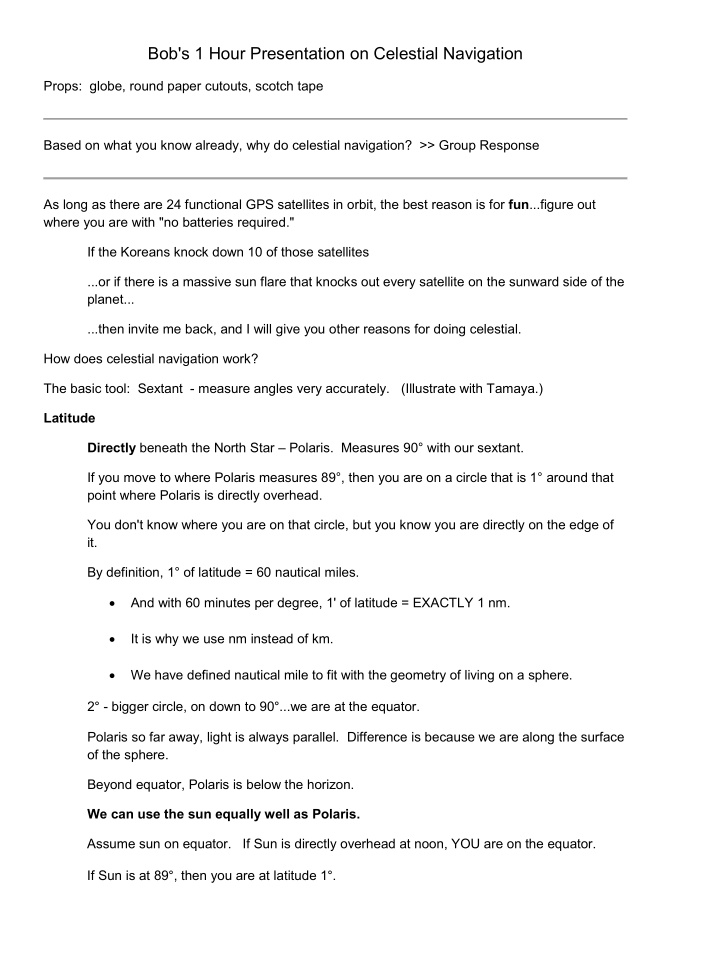



Bob's 1 Hour Presentation on Celestial Navigation Props: globe, round paper cutouts, scotch tape Based on what you know already, why do celestial navigation? >> Group Response As long as there are 24 functional GPS satellites in orbit, the best reason is for fun ...figure out where you are with "no batteries required." If the Koreans knock down 10 of those satellites ...or if there is a massive sun flare that knocks out every satellite on the sunward side of the planet... ...then invite me back, and I will give you other reasons for doing celestial. How does celestial navigation work? The basic tool: Sextant - measure angles very accurately. (Illustrate with Tamaya.) Latitude Directly beneath the North Star – Polaris. Measures 90° with our sextant. If you move to where Polaris measures 89°, then you are on a circle that is 1° around that point where Polaris is directly overhead. You don't know where you are on that circle, but you know you are directly on the edge of it. By definition, 1° of latitude = 60 nautical miles. • And with 60 minutes per degree, 1' of latitude = EXACTLY 1 nm. • It is why we use nm instead of km. • We have defined nautical mile to fit with the geometry of living on a sphere. 2 ° - bigger circle, on down to 90 ° ...we are at the equator. Polaris so far away, light is always parallel. Difference is because we are along the surface of the sphere. Beyond equator, Polaris is below the horizon. We can use the sun equally well as Polaris. Assume sun on equator. If Sun is directly overhead at noon, YOU are on the equator. If Sun is at 89 ° , then you are at latitude 1 ° .
88 ° for sun = 2 ° for you. With nothing but a sextant, you can navigate the globe. Latitude Sailing – Joshua Slocum 1895 – Samoa 14 ° 18' South If from there, you want Fiji, use your compass to sail south (and a little west is OK) until you get to 18 ° S, then turn due west. Then, like Slocum, if you want to get to Sydney, Australia, sail SW until you get to 33 ° 13'S and turn due west. Up into the 20 th century, this was the way that most people navigated the oceans: with a sextant, a compass, and a chart. No other equipment required. Longitude But to sail safely, it helped to know you longitude as well. Train illustration....running E-W If you have an accurate watch, and you know the schedule of the train, you can know where you are. Instead of a train at 100 km/hour, think of the sun at 1,670 km/hour. We still know what its schedule is: NAUTICAL ALMANAC. Gives us the schedule of the sun for every hour of every day for a whole year...and for every second of every minute of every hour. Works for the moon, planets and stars as well. If you have a watch, you can know your longitude, and with your sextant, you know your latitude. John Harrison – 1759 – marine chronometer. 4 th try...called H4. Captain James Cook used K1, the first copy of Harrison's watch (H4), when he sailed to Tahiti. William Bligh (of Mutiny on the Bounty) used K2, the second copy. The THEORY of sailing directly for your destination was in place by 1759...but a chronometer could cost as much as the rest of the ship put together. ...explains why Slocum was still latitude sailing in 1895. 20 th c., commercial ships all had chronometers...but was pretty expensive for the recreational sailor. 1969, Seiko brought out the world's first quartz wristwatch, and transformed navigation. Golden age of celestial for small boat sailor with limited budget was short.
Accurate...but more important...CONSISTENT. My watch gains 0.18 seconds per day. But it does that no matter where I am or what I'm doing. Modern Celestial Navigation Practiced by a handful in 18 th c. • • By Navy, plus some merchants in 19 th c, • By merchants and Navy in early 20 th c, and... • By everybody in late 20 th c. Fundamentally simple: • Tell me where you think you are. • Tell me where the sun is . • And I will tell you how high the sun should be. Tell me where you think you are: lat./long. of where we think we might be. Tell me where the sun is: Nautical Almanac. (Train on its schedule.) I will tell you how high the sun should be: Sight Reduction Tables If you are where you think you are, then your sextant agrees perfectly with the SR tables. If the sun looks lower, then you are further away. If the sun looks higher, then you are closer...at the rate of 60 nm for each 1° of sextant difference. Accuracy: • GPS good to within 5 or 10 feet, or even better. • Celestial good to 1 to 3 nm of accuracy,. 1 sight: 1 circle of position. If Moon is visible at same time as the sun, you can get a fix. Prime time for navigators is just before dawn and just after sunset. Light enough to see the horizon, but dark enough to see planets/brighter stars. Can get a fix. There are procedures for using Nautical Almanac and SR tables, and for plotting your position on a chart. But fundamentally, it is simple. 25 hours of instruction and you will master the techniques such that you can navigate yourself across oceans, anywhere on earth.
Recommend
More recommend